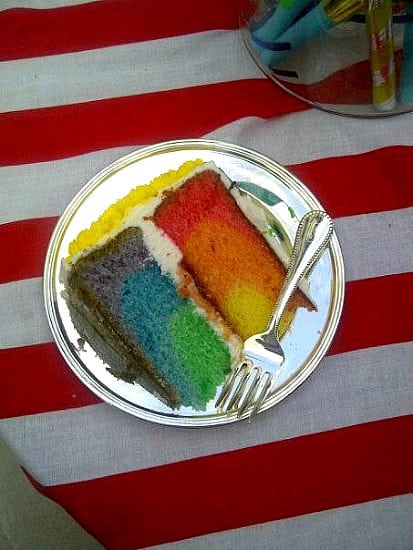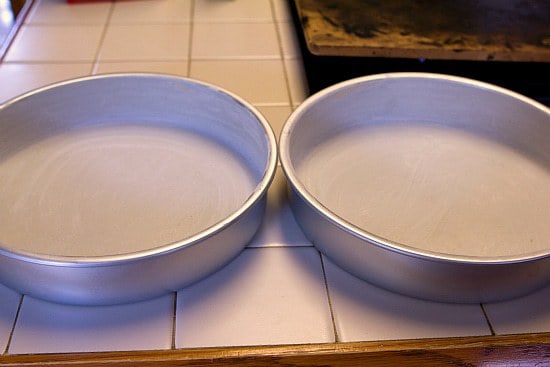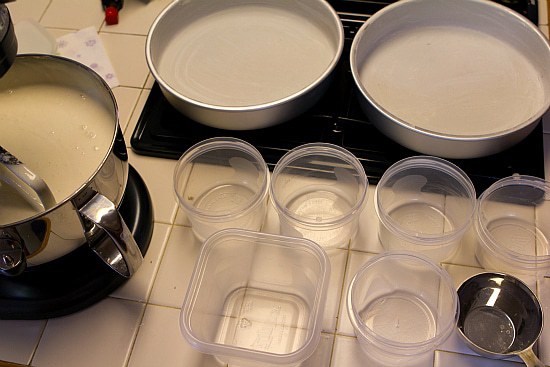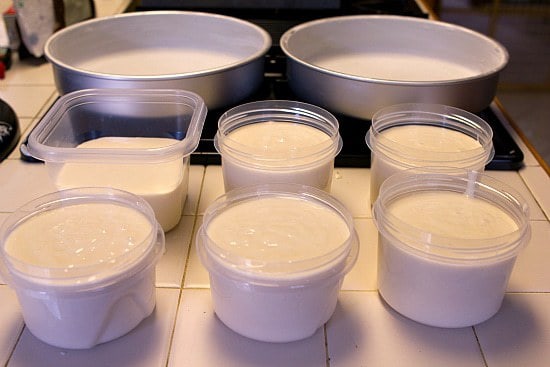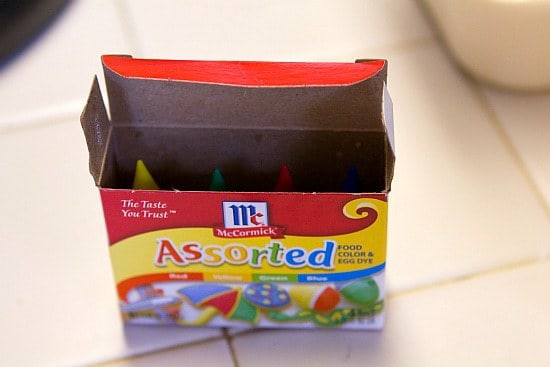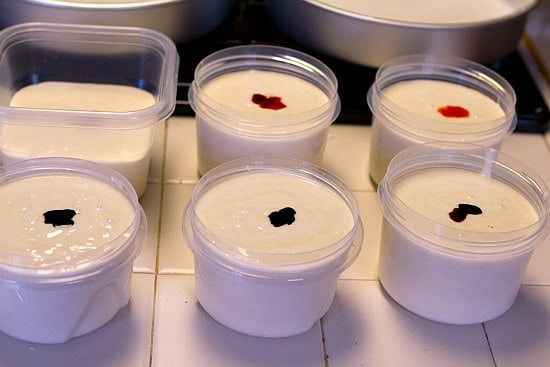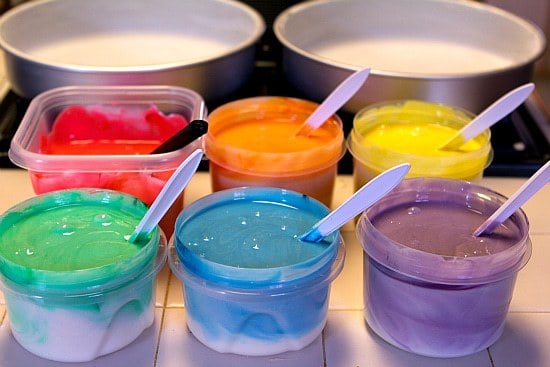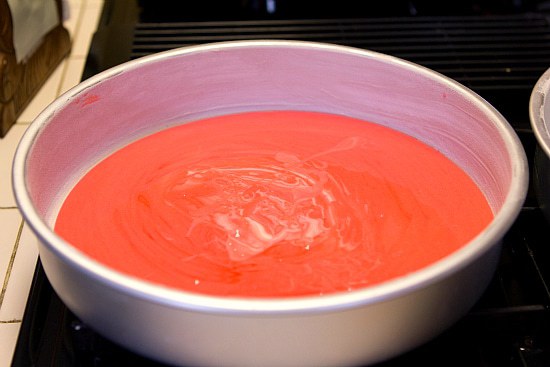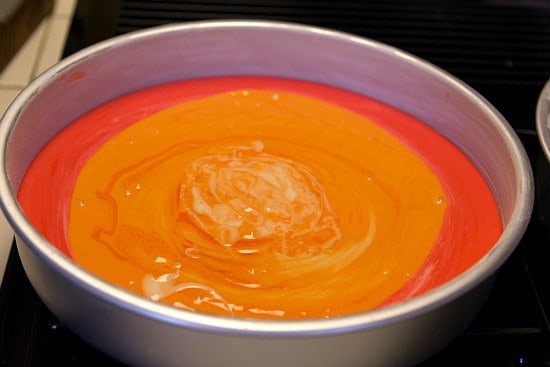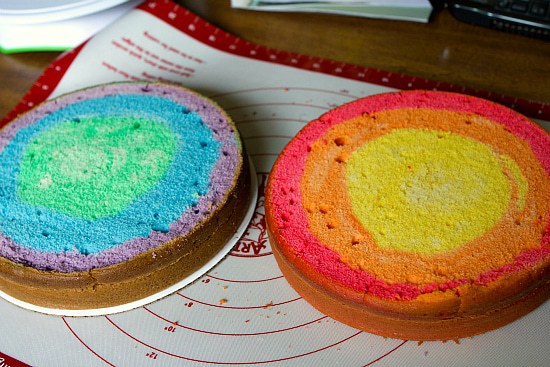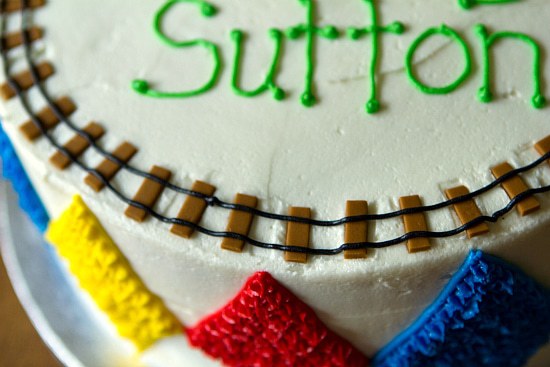Macarons are a French delicacy I am completely crazy about.
Since I can’t always be in Paris close to my favorite pastry-chef,
Pierre Hermé, I have decided to make my own. It’s not an easy task, and
it needs a lot of patience. I learned how to make them in Paris, but
when I came back I searched around the internet for some recipes
providing the perfect ratios. I learned the hard way that macarons are
capricious little wonders: add a bit of this or that, and your delicate
balance tips over; I’ve seen my share of overbaked, flat, cracked or
overinflated numbers coming out of my oven. No recipe is universal, and
the most important thing is to go slow. Try cautiously with your own
instruments, ingredients and oven. You
will have to try more than once before achieving perfection. If they were so easy to do, wouldn’t everyone make them?
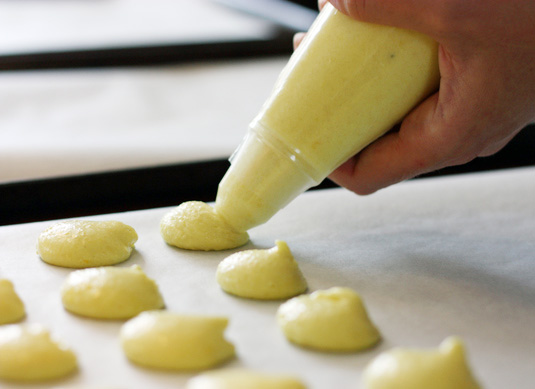
When I was looking around for recipes, I found plenty but few had
illustrated steps to guide you through what’s OK or not in terms of
texture, color and result. Since you can’t always have an experienced
teacher showing you the first time, I figured I would allow you to
benefit from my
apprentissage and help you get to a happy result more quickly.
No single source can be given as a base for my recipe. I have
gathered dozens left and right, tested and tasted and ended with my own
proportions. Now I (almost) always make them successfully, so this is a
good base to start with. I will guide you through the rest.
-
Having trouble making macarons? Since first publishing this post, struggling macaron-makers have asked me every question under the sun
. After
over two years (and hundred of comments!), I’ve decided to close the
comments on my macaron posts, but I’m not leaving you an excellent
resource: I’ve gathered the most frequently asked questions I’ve been
asked about macarons in one single post:
A Macaron Troubleshooting Guide: Useful Tips and Advice to Master the French Delicacy.
If you’re having any trouble making macarons, chances are you’ll find
answers in that post. You can also read through the comments left below,
I did my best to reply to all of them and many (if not all!) macaron
issues are covered in there as well.
If I missed something,
send me a note and I promise I will keep on editing the troubleshooting post once in a while!
-
I have put together a short 5-minute video that shows you the key steps in making French macarons at home. There’s
nothing like having someone show you the way – at least, that’s how I
learned. The video, along with this post’s detailed instructions and
pictures, should allow anyone wanting to make this French delicacy at
home succeed.
Watch the video below, or better yet,
click here to view it in high-definition on YouTube. You’ll be able to read the instructions more easily and see all the important details much better.
See also
my “All About Macarons” page for more resources and links.
-
Macarons: Basic Recipe
These ingredients will make the cookies. This is the base and what’s
hardest to master. You should try to successfully bake a couple recipes
of basic macarons before trying to mix in other flavors.
3 egg whites (from large eggs), separated at least 24 hours in advance and kept in the refrigerator
210 g powdered sugar
125 g almond meal
30 g regular granulated sugar
What you need – equipment:
It’s best to gather all the equipment you really need before starting.
Yes, I did have to buy some of these tools before making my first
macarons. The good thing is that none of the following tools are
specific to making macarons so your new gadgets will help you make many
other great desserts. Please, do take this excuse and go shopping. :)
Kitchen scale (yes, you do have to measure in grams, it’s more precise)
Food processor (really nice to have but not mandatory)
Hand or stand mixer with whisk accessory (mandatory unless you’re very courageous and/or strong)
Sifter or fine sieve
Big stainless steel bowl (
cul-de-poule)
Another big mixing bowl
Spatula
Pastry bag and round tip (1/2 to 3/4 inch opening)
Large baking sheets, preferably 2 to 4 of them
Parchment paper
Various food color (liquid, gel or powder are all good)
A couple of days before you plan to make your macarons:
Prepare your eggs. Separate them, putting the whites in a clean
airtight container and reserving the yolks for another use. Now, your
egg whites must “age”: they need to spend at least 24h (up to 5 days) in
the refrigerator before you use them.
The morning of the day you plan to make your macarons: Take your egg whites out of the refrigerator and leave them to temper at room temperature for several hours.
Making the cookies:
Measure the powdered sugar and almond meal and put them in the bowl of your food processor.
Finely grind
the two together for a minute or two. Stop the processor, scrape the
sides and bottom of the bowl, and process again for a minute.
Yes, you need to do this even though both
ingredients are already powdered. This step blends the sugar and nuts
perfectly together and gets rid of bigger bits that often remain in
packaged almond meal.
You can grind your own almonds, just make sure they are
peeled. And that you very finely grind them (add the powdered sugar to
the almonds when they are coarsely ground to make sure you don’t end up
with a paste).
If you don’t have a food processor, you can still make
macarons, but make sure to really thoroughly blend the almonds and sugar
together. The consequence is that the texture of your macarons won’t be
as soft and smooth.
After processing the powdered sugar and almond meal, you have to
sieve the mixture.
This is really important (especially if you don’t have a food
processor) as it will get rid of the remaining bigger bits and ensure a
smooth batter. You will see some of the almond refuses to pass though
your sieve (see picture below). Don’t try to force it through; it’s ok
to throw it away. The quantity shouldn’t be significant enough to
unbalance your recipe.
Here’s what I generally have left after I sieve half of my almonds-sugar mixture:

Set this bowl aside and
take your bigger stainless steel bowl out. This kind of bowl is called a
cul-de-poule
in French and they are so useful in a kitchen that, if you don’t have
one already, you simply really should invest in a couple of them
(different sizes). Stainless steel bowls helps egg whites get fluffy and
firm.
Make sure your bowl is cold. Stainless steel usually
remains cold by itself, but if it’s not, rinse it under cold water (or
stick it in the freezer for a couple of minutes) and dry it before
continuing. A cold bowl also makes egg whites happy.
Make sure your granulated sugar is measured and close to your working area.
Put your egg whites in the bowl.
Start beating them at medium/high speed with your mixer. Once they
start to get bubbly and white and you see your whisk is lightly leaving
marks, add a tablespoon of the granulated sugar.
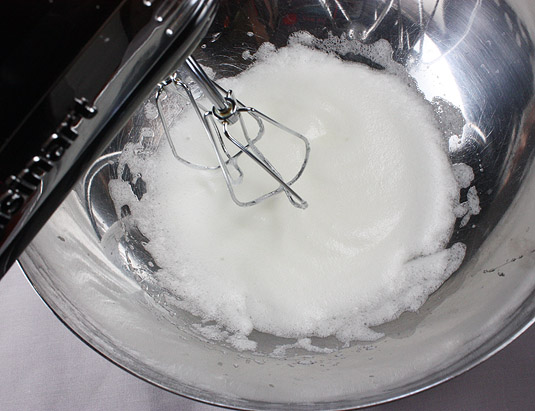
Continue beating and add the remaining sugar slowly over the next
minute or two. Your eggs will now be white and fluff but not stiff
enough. Continue beating at high speed until peaks form and remain up
when you take out your whisk (stop your mixer before trying this!). When
the egg whites are ready, you’ll notice that they seem
dense and creamy and not as bubbly anymore. Here’s what they look like:
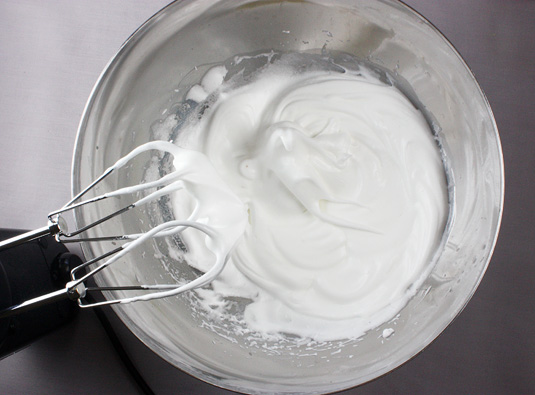
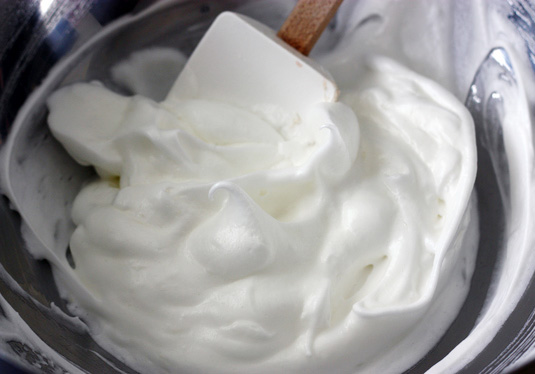
Now is the time to put your electric appliances aside.
Your egg whites are delicate and you must treat them gently. If you wish to add color, now is the time to do so. I made
lemon macarons. I added 15 drops of yellow liquid food coloring and the very finely grated zest of one lemon.
Gently fold in the color using a spatula:
slide your spatula on the side of the bowl under the egg whites and
bring the bottom up to the top. Repeat this until the color is evenly
blended. Now is not the time to be in a hurry:
DO NOT whisk at any cost as it will deflate your
egg
whites and your batter will be ruined. At this point, the color of your
batter (if you added food coloring) should be at least as intense as
you want the final macaron to be. It will intensify and brighten a bit
when you add the almonds/sugar mixture.
The batter is now matte, light and fluffy:
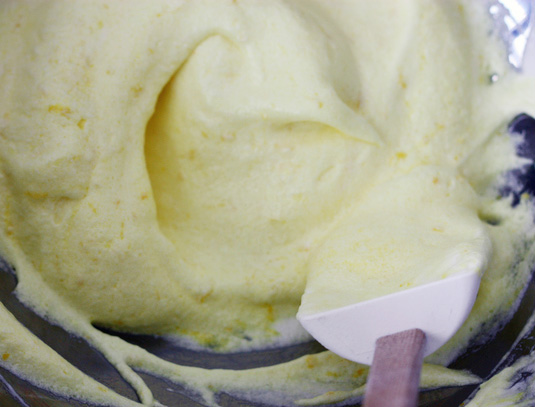
Continuing your folding motion,
start mixing in your dry ingredients a little at a time
(you should add the whole thing in 4 or 5 additions). Carefully blend
everything together, always sliding your spatula to the bottom of the
bowl and back up to make sure no pockets of dry ingredients remain.
When your batter is evenly blended, it will look shiny and creamy:
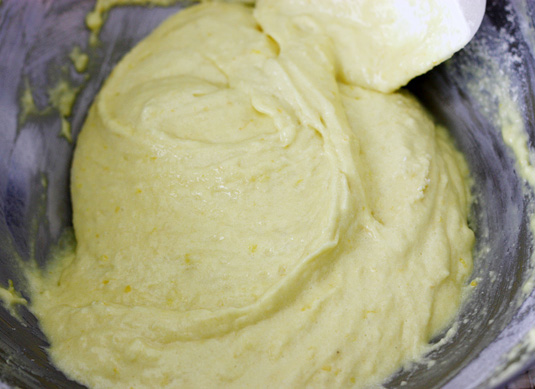 Prepare your baking sheets.
Prepare your baking sheets. Double the baking sheets
(helps macarons rise and cook more evenly) then cover each with a
well-measured sheet of parchment paper. I have tried silicon mats before
and I don’t think they work well with macarons. Their rubbery texture
seems to cling to the delicate and somewhat sticky cookies so that you
more often than not end up with empty shells (the tender insides
remaining stuck to the silicon).
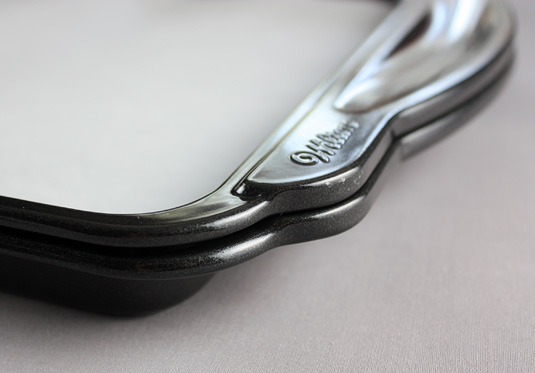
Now is the time to
fit your pastry bag with its tip. I like to use
disposable pastry bags
that I wash 3-4 times before getting rid of them. I find that plastic
pastry bags are more flexible and easier to work with than textile bags.
They are also really easy to clean just by letting hot water run
through them and they don’t stain.
To make the transfer from bowl to pastry bag easy, I
stand my pastry bag in a measuring cup,
folding or twisting the tip to make sure the batter doesn’t come out
too quickly. If your pastry bags are long, fold it in half to make sure
the batter gets to the bottom of the bag.

Take your bag out of the cup, keeping the tip folded or twisted so
that the batter doesn’t come out. Unfold the larger end of the bag and
twist it shut close to the batter to push it down. As you lay your
macarons on the cooking sheets, you will continue this motion (twisting
the larger end of the bag with one hand) to put constant pressure on the
batter and ease its way out on the sheets.
Now is the time to work your magic: you have to hold the tip of your
bag with one hand to guide it, and hold the larger end with your other
hand to push the batter down. Place your tip close to the parchment
paper and twist the end of the bag so as to push the batter down and out
to form 1 to 1.5” disks. You can set your macarons pretty close
together as they won’t expand while cooking. When enough batter is out,
stop twisting the end of the bag and swiftly lift your tip up to stop
the batter from coming out. This is tricky:
you will need practice. Mastering this technique will ensure your macarons are uniform in size and round.

Now, don’t panic. Your macarons have a pointy tip that makes them look like lazy Hershey’s Kisses. Not to worry:
as they rest before cooking, they will smooth out.
You can help them though: lift your baking sheet up a bit and firmly
bang it on the table a couple of times. This will even the caps and take
the air bubbles out of them.
If you’re a perfectionist like I am, now is a good time to edit your
macarons to make sure they will be perfectly round. I use a small
silicon spatula to make oval caps round or smooth down tips that won’t
come down.
This step is absolutely not mandatory; imperfection can be very charming.
The next step will once again test your patience: you have to
let your macarons rest on the baking sheets at room temperature for at least 20 minutes (some say a couple hours is best but I’m not
that patient). You just have to. This step will “dry” the caps and help them rise later when they cook.
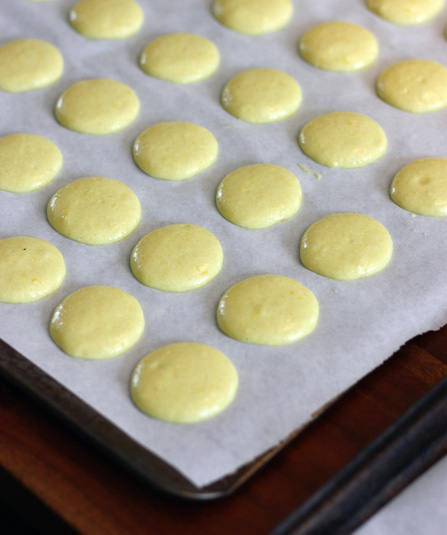
Halfway through the wait, preheat your oven between 275 and 300°F (135-150°C).
Every oven behaves differently.
I have a gas oven and 300°F (150°C) is generally good for me. In some
ovens, this temperature can be too hot, especially for light-colored
macarons (you don’t want them to brown). I prefer to play it safe, cook
them at a lower temperature and leave them longer in the oven. You will
have to test your own oven and stay close to it to watch over your
macarons as they cook.
I baked these lemon macarons at 300°F (150°C) for 14 minutes.
Your cooking time could be anywhere between 13 and 18 minutes. From 12
minutes on, watch closely, and avoid opening your oven door before that.
Your macarons are ready when they look dry and matte and seem firm on
their crown when you lightly tap on them.
Overcooking the macarons will make them too crunchy and feel like meringue.
Undercooking
them will make them separate when you try to lift them off the sheets. I
know, it’s tricky! After a while, you will know your oven and get
better at figuring when your macarons are done. In any case, please play
it safe when setting your oven temperature.
Excessive heat is the macaron’s worst enemy: they will cook too quickly, cracking like meringue and browning, hiding their beautiful color.
When they are done, take the sheets out of the oven and let them cool
on a rack. If you need to reuse your baking sheets for the next batch,
let them cool 5-10 minutes in the baking sheet and then lift the
parchment paper out of the sheet to set it directly on the cooling rack
(this is why it’s good to have more than 2 sheets).
Once cooled to room temperature, your macarons are ready to be assembled.
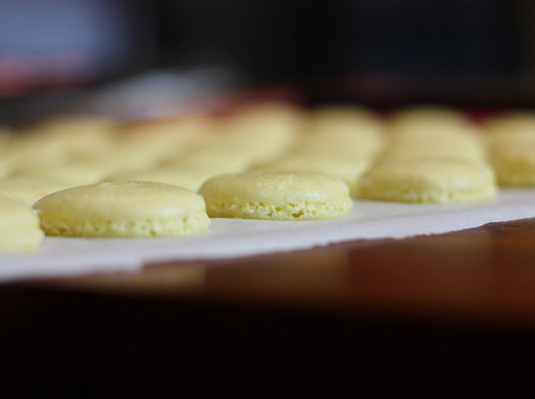
When they are perfectly cooked, they should lift easily from the
parchment paper, have a flat bottom and a beautiful puffy crown. If they
stick a bit, help them up with a thin stainless steel spatula so that
they don’t separate or break. If they’re a bit overcooked, they will be
hollow under the cap. You can still use them, you’ll just have to put
more cream to assemble them (yum!).
Match the cap sizes that fit best together. For the filling, the
possibilities are as great as your imagination is. For lemon macarons,
you can fill them up with lemon curd as I did, or with a lemon-flavored
buttercream. If you made pink cookies, fill them up with good-quality
raspberry preserves or, if you feel decadent, with a mixture of
mascarpone cheese and preserves. The only thing that’s important is to
make sure the filling is firm enough to not drip out from the macarons.
A great macaron should be able to stand on its side and not lose its filling.
Using an icing spatula (or just a regular butter knife) spread your
icing on one cookie. Place the other cookie on the icing and press
gently to stick them together.
Once all of your macarons are assembled, in an ideal world, you would
put them in an airtight container, in the refrigerator and let them rest for another 24 hours. Yes, you need patience once again. They won’t be
bad
if you eat them right away. Letting them rest with their icing in
really reveals the fine texture of the macaron. The humidity of the
icing will get into the crispy caps and that’s what will make them crisp
on the outside and so tender on the inside. Try to be patient, trust
me, it’s really worth the wait. The good thing is that
it’s a great dessert to make in advance and it will for sure impress your guests. They will be at their best if you eat them in the next 4-5 days.
Yes, these French cookies are a really fancy delicacy. No, they’re
not easy to make. Yes, they require time, patience and practice to
master. But it’s worth it really, and less expensive than a plane ticket
to Paris.
Source: http://foodnouveau.com/2010/03/29/destinations/europe/france/how-to-make-macarons-a-detailed-illustrated-step-by-step-recipe/

 ) is sometimes read aloud in the form of a conditional sentence (i.e. "if p, then q"),
the intuitive interpretation of conditional statements in natural
language does not always correspond to the definition of this
) is sometimes read aloud in the form of a conditional sentence (i.e. "if p, then q"),
the intuitive interpretation of conditional statements in natural
language does not always correspond to the definition of this 
